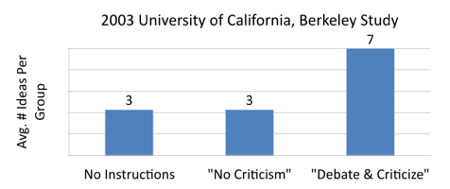Everything You Heard About Brainstorming Is Wrong: How Data Disproved the Two Universal Rules of Brainstorming
1. The Monster TED Talk That Fell From Grace
Amy Cuddy’s TED Talk on power poses is the second most popular TED video ever, having been viewed over 50 million times. In experiments she conducted at Princeton, participants were divided into two groups: half engaged in so-called ‘high power poses’, such as standing up with your hands on your hips; and half did ‘low power poses’, where they curled into balls looking meek. Each group spit into vials before and after their poses, and the results were astonishing.
The group doing high power poses saw their testosterone skyrocket, simply by doing those poses. The converse was true of the group doing low power poses. Aside from being insightful, this provided a great tool for the introverted and shy to instantly feel more powerful in all kinds of situations. I’ve even referenced her talk in classes I’ve taught on building your personal brand.
There’s only one problem with it. It’s wrong.
A blistering cover story in the New York Times Magazine (When the Revolution Came for Amy Cuddy) pointed out that Cuddy’s results couldn’t be replicated in repeated experiments. She became the poster child for a whole slew of social psychology experiments whose results have since been debunked by experts.
Cuddy’s story is a great example of something that just feels intuitively right, even though there’s no actual data to back it up. Brainstorming is another one.
2. The Cardinal Rules of Brainstorming
It’s almost universally accepted that the two core tenets of successful brainstorming are:
- Getting everyone together in a room to exchange ideas, and
- No criticism; there are no ‘bad ideas’
Like Cuddy’s power poses, this is simply wrong. Not only is there no data to support this method, but the data that is available actually proves that BOTH steps provide fewer ideas and ideas of weaker quality than doing the exact opposite.
In 1948 Alex Osborn, a partner at ad agency BBDO, published a book called Your Creative Power. He claimed that you could double your creative output by engaging in an ‘absence of criticism’. According to Osborn, “Creativity is so delicate a flower that praise tends to make it bloom, while discouragement often nips it in the bud. In order to increase our imaginative potential, we should focus only on quantity. Quality will come later.”
Seems utterly logical, right? No one likes to have their ideas criticized, and this provides a supportive environment for shy people to come forward with creative thinking. The problem is it had never been tested.
3. Brainstorming: Everything You Were Told Is Wrong
A 1958 Yale University study gave 96 people a series of creative puzzles. Half of them worked in groups of four, while the other half worked independently. The group that worked independently came up with twice as many solutions as those that worked in teams of four. Further, the independents’ solutions were deemed “more feasible and effective”.
So much for the first rule: brainstorming in groups. But surely the second rule, no bad ideas, was rock solid, right? (You can probably tell where this is going.)
A 2003 Berkeley study took 255 students, divided them into teams of five, and asked them to devise solutions for reducing traffic in the Bay Area. The teams were further organized into three groups. One group was given no instructions. A second group was told to observe the “no criticism” rule. And a third group was instructed to debate and criticize ideas as they saw fit.
The first two groups generated an average of three ideas per group, while the third group of teams, which engaged in debate and criticism, delivered seven ideas on average, more than double the other two groups.
And thus the second and most iconic brainstorming concept, ‘no idea is a bad idea’, is, actually, a very bad idea. (Think about the irony of that statement for a moment).
4. Conclusion
The concept of ‘Big Data’ has gotten a lot of buzz in recent years, and many people, rightly, are accessing deeper troves of data about their events. Event registration data, for example, is being analyzed up the wazoo, providing micro insights on attendee personas in an effort to improve event turnout and guest engagement.
But perhaps one of the key takeaways here is that data might also tell you things that are counterintuitive, unpleasant, and overturn deeply held assumptions. A pair of quotes from university researchers on the two brainstorming tenets perhaps sums up this insight best.
“Maybe debate is going to be less pleasant, but it will always be more productive.”
– Charlan Nemeth, professor of psychology at Berkeley.
“Decades of research have consistently shown that brainstorming groups think of far fewer ideas than the same number of people who work alone and later pool their ideas.”
– Keith Sawyer, a psychologist at Washington University.
What long held assumption about your events or your teams is sitting under your nose, waiting to be disproven? Comment below!
Author: Howard Givner is the Founder & Executive Director of the Event Leadership Institute. He can be reached at howard@EventLeadershipInstitute.com



